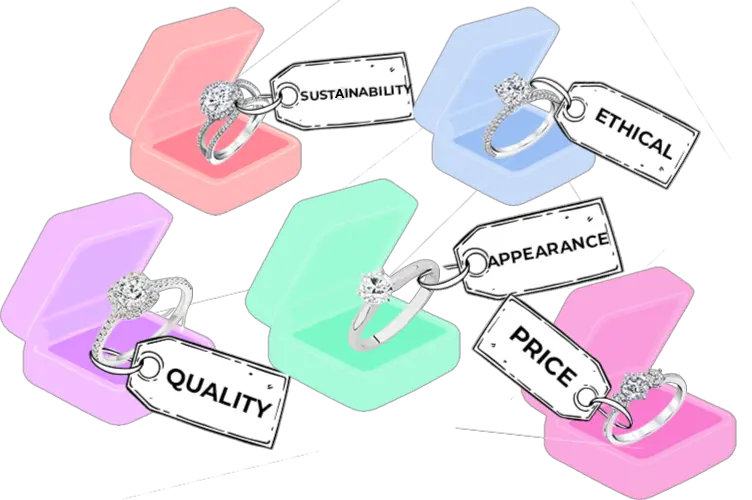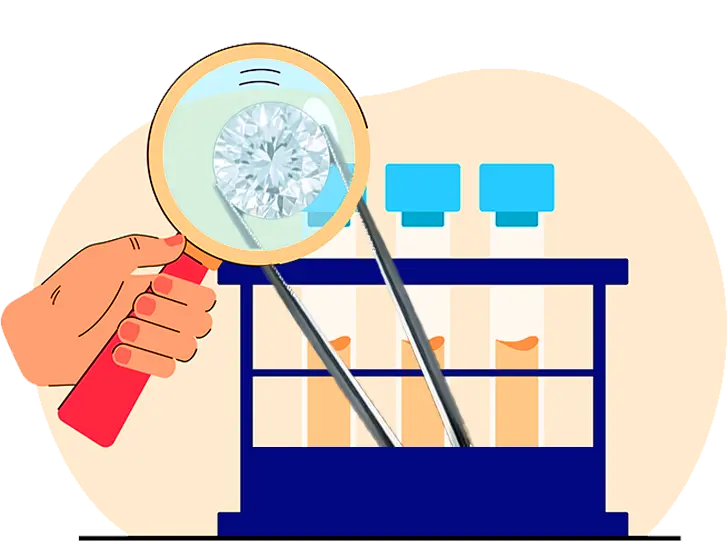
As groom-enthusiasts prepare to get married, it’s increasingly important for them to start finalizing an engagement ring purchase. When it comes to wedding bands, there’s a lot of confusion about stone options and which stones are visually stunning and ethically sourced. To help clarify this topic, we’re taking a closer look at the two main types of diamonds: lab grown and natural.

Lab grown diamonds are created in a controlled environment using cutting-edge technology. This approach means they are perfectly uniform in size and shape, with no imperfections, offering a gorgeous stone for an engagement ring.
Natural diamonds, on the other hand, are mined from the Earth. They vary in size and shape and often have imperfections. But for some grooms, the uniqueness of a natural diamond is part of its appeal.
Learn more about lab grown diamonds and why they are preferable for grooms looking to impress their soon-to-be fiancees with a stylish and ethically sourced diamond ring.
Lab grown diamonds are real diamonds; however, these stones originate in a lab rather than under the Earth’s mantle. Lab grown diamonds are made using two different methods: Chemical Vapor Deposition (CVD) and High-Pressure High Temperature (HPHT).
HPHT is the process typically used to create larger diamonds, and it involves subjecting a seed crystal to high pressure (730,000 PSI) and high temperatures (1,400°C or 2,550°F) to make the stone.
Carbon Vapor Deposition (CVD) is typically used to create smaller diamonds. It involves placing a piece of carbon in a chamber and subjecting it to a plasma, which vaporizes the carbon and deposits it onto the seed crystal. Over time, this process results in the formation of a diamond.
Diamonds are formed deep within the Earth under extreme heat and pressure conditions. Over time, these carbon molecules tightly bond together, transforming them into beautiful gems.
Extracting diamonds from the Earth can damage the environment and sometimes become a financial commodity in conflict zones. For years, conflict diamonds have been used to finance civil wars and other forms of violence. An estimated 140,000 carats of diamonds, worth $24 million, have been smuggled out of the Central Republic of Africa since the suspension.
For example, the Marange diamond fields have been a source of contention in Zimbabwe for years. The government has been accused of using forced labor to mine the diamonds, and there have been reports of human rights abuses. Recently, villagers in the area have been protesting against the government’s policies. The situation is still tense, and the diamond trade is still fueling human suffering in Zimbabwe.
Man-made or natural, diamonds are carbon in crystalline form, making them real diamonds. However, some differences exist between natural and lab grown diamonds. The following show how these two types of diamonds differ in resale value, quality, sustainability, and appearance:
The quality of a diamond is judged by the 4C’s: cut, color, clarity, and carat weight. All other factors being equal, lab grown diamonds are chemically identical to natural diamonds (although natural diamonds contain a trace amount of nitrogen). This means they have the same optical and physical properties.
Since they are grown in a controlled environment, lab grown diamonds tend to be more uniform in quality than natural diamonds, which can have more inclusions and blemishes.
Lab grown diamonds are more sustainable than natural diamonds because they do not require mining. The only inputs required for lab grown diamonds are water and energy, both of which can be sourced from renewable sources.
Additionally, lab grown diamonds have a smaller carbon footprint than natural diamonds. Natural diamond mining produces 57,000 grams per carat of carbon emissions, while lab grown diamonds produce a minuscule 0.028 grams per carat. This makes lab grown diamonds a better choice for eco-conscious grooms shopping for engagement rings.

There are some subtle differences between the two types of diamonds in their appearance. Lab grown diamonds tend to have fewer inclusions, or imperfections, than natural diamonds. They also tend to be more uniform in shape and size. However, these differences are usually only visible under magnification, so lab grown and natural diamonds look identical to the naked eye.
Lab grown diamonds have little to no resale value. This means you won’t be able to recoup your investment if you need to sell or trade the diamonds later. The poor value retention is partially due to their relatively easy manufacturing process. Comparatively, natural diamonds depreciate by approximately 50% after purchase.
Lab grown diamonds are cheaper than natural diamonds, although the exact price difference depends on the specific diamonds.
In general, diamonds offer a more affordable option for those looking to purchase a diamond ring or other piece of jewelry. You may pay 30% to 40% less for a lab grown stone versus a natural diamond. As the technology improves and becomes more efficient, the price of lab grown diamonds will likely continue to drop.

Both types of diamonds are made of carbon and have the same chemical structure and physical properties.
One of the most common questions about lab grown diamonds is, do lab grown diamonds pass a diamond tester? The answer to this question depends on the type of tester used.
Made to detect fake diamonds like those made of quarts, moissanite, or glass, most commercially available testers will identify lab grown diamonds as diamonds during an examination. If you’re on the fence about lab-grown diamonds and their authenticity, check out this handy article. It’ll guide you on how to tell if a diamond’s truly legit or not.
A trained gemologist may be able to tell lab grown diamonds from natural diamonds with a standard diamond tester. CVD diamonds will usually test as diamonds on these testers, while HPHT diamonds may not. This is because HPHT diamonds may contain trace amounts of boron, giving them a slightly blue hue. This color and chemical composition causes the tester to register the HPHT diamond as synthetic moissanite.
As a groom looking for a ring for the person you love, there are many reasons you should consider buying a lab grown diamond engagement ring over other options. Sales of lab grown diamonds increased to 28.4% in 2021, highlighting the growing popularity of these stones.
Lab grown diamond engagement rings are significantly cheaper than natural diamonds. On average, lab grown diamonds cost about 30% less than natural diamonds of the same size and quality. A 2021 report from BriteCo found that the average cost of a lab grown diamond ring was $4,383, whereas a natural diamond ring cost around $8,053. Learn more about average engagement ring costs here!
Lab grown diamonds can be an excellent option for couples on a budget but still want a beautiful, high-quality engagement ring without having to finance or spending a substantial amount of money.
Lab grown diamonds are much more environmentally friendly than natural diamonds. The process of mining natural diamonds is very damaging to the environment, causing pollution and the destruction of ecosystems. On the other hand, lab grown diamonds are created in a controlled environment using renewable energy sources.
The process of mining natural diamonds often results in human rights abuses, as well as damage to local communities. Despite the Kimberley Process, a certification program to prevent conflict diamonds from being sold worldwide, diamond miners are still treated poorly in many countries. Lab grown diamonds are ethical diamonds created in a controlled environment by skilled workers who are paid fair wages.
While both lab grown and natural diamonds have the same rating on the Mohs Hardness Scale, natural diamonds typically have more inclusions and flaws than lab grown diamonds. In rare cases, inclusions can cause natural diamonds to crack or break under pressure.
From iconic A-listers like Lady Gaga and Zoe Kravitz to rappers like Drake, more celebrities are choosing to make a statement with their social choices. For socially-conscious fashion-forward brides and grooms, a lab grown diamond engagement ring sends a message that you can about the environment and you back up your principles when making significant purchases.

Your wedding day is one of the most important days of your life, and you want everything to be perfect. A lab grown diamond is a great choice if you’re looking for an ideal ring and want to save money. Now that you’re more prepared to buy an engagement ring, it’s time to prepare for your proposal. If you’re feeling stuck on how to propose, we’ve got tips!
The Groom Club is a blog and community created to support grooms through the planning and processes relevant to them. From bachelor party planning and wedding traditions to costs and groom etiquette, we are an accessible, inclusive, and informative resource.
Whether you’re just getting started or down to the final details, The Groom Club is the perfect place to turn for guidance, support, and friendship.